GARY EOFF
Artist / Craftsman / Haumana 'ia Hawai'i
-
IPU WAI PĀWEHE - Dyed Gourds
Open or CloseDyed gourds that are covered with designs were unique to Hawai‘i and were highly valued and passed down from generation to generation as heirlooms. To create the patterns and designs, the outer skin is scraped away leaving some areas where skin is left. A liquid plant dye made from kukui bark is placed inside the gourd, and the areas where the skin is left, the gourd turns dark.
The design on this gourd tells the legend of Hawai‘i Loa, the Chief who led his canoes to discover Hawai‘i and gave the islands their name. He was guided by the ‘iwa (frigate) bird, the manō (shark) and the star, Hokuleā. Hōkūle‘a is the zenith star over the Hawai‘ian islands that is still used today to guide voyagers to Hawai‘i.
The design of the rounded triangle panels resemble the triangular lashings used to tie carrying gourds. At the bottom is a Maltese Cross, the sign of water. The first set of panels depicts the sea urchin. The next set of panels depict the teeth of an open shark mouth using triangles and alternate with the sea urchin design. The large central panels depict the islands in the sea with the five major peaks of Hawai‘i island alternating with designs of the ‘Iwa bird (the M shape) in flight and the shark (the triangle shape). The very small panel above depicts the guiding star, Hōkūle‘a. The neck is circled by ‘Iwa Birds and above them, the stars in the sky, completing the picture from the bottom of the ocean to the heavens.
The shell stopper was used as a screw top to seal in the water. -
IPU HAWELE - Tied Carrying Gourds
Open or CloseIn Hawai‘i over 20 varieties of gourds were grown of different shapes and sizes, for many uses. There is no clay in Polynesia, and no ceramic pottery. Gourds were the container used.
The long, narrow neck on the water gourd made carrying and pouring water easy. Shell stoppers formed a spiral screw in the long neck to keep the water fresh and avoid spilling.
Water for household use had to be carried from the water source to the house in a large gourd. A strong net was tied on the gourd to make transport easy and gourds would hang on the ends of a stick balanced over the shoulders.
In the old days, hand made cordage was time consuming to make and very valuable. The lashing technique was particular to Hawai‘i. It starts and ends with a knot, with slipknots used in between, so the cordage would be easy to retrieve if the gourd broke or was needed elsewhere.
A smaller gourd was used as a canteen for personal use when tending fields, fishing or travelling. -
HĪNA‘I HO‘OMOE I’A - Coarse Basket for Fish
Open or CloseA large coarse basket with tight fitting lid, twined out of ‘ie ‘ie, is used to store dried fish, a staple of the Polynesian diet. If the dried fish were kept in closed gourd containers, they would soon spoil. Air-flow is needed to keep them for long periods.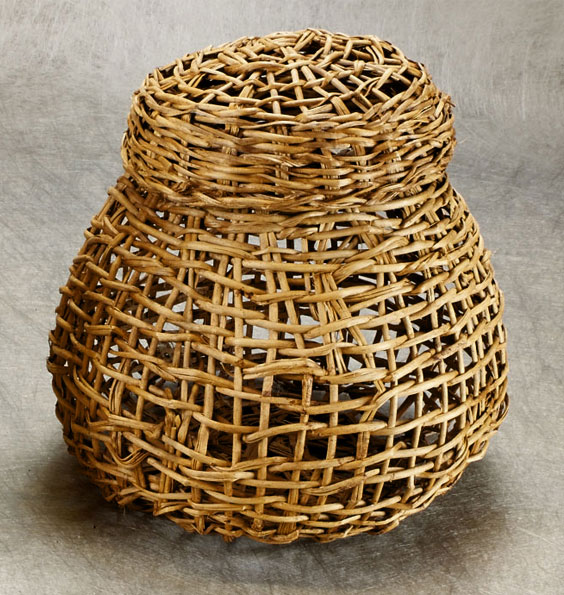
This basket is made from the aerial roots of the ‘ie‘ie plant that must be carefully gathered from the forest. It is no longer as abundant as it was. It is difficult to gather, and care must be given to the plant during harvest, so as not to harm the mother plant. The aerial root is covered with a thin bark that is carefully scrapped off within a week of gathering. The cleaned root is dried to cure it for use. When ready for weaving, it is soaked to make it flexible, then split and graded for size.
Each basket is woven free-form, and every shape is unique. This basket is dyed with a traditional dye of kukui Tree bark, which acts as a preservative.
-
HĪNA‘I HO‘OMOE ‘ŌPAE - Coarse Basket for Shrimp
Open or CloseA coarse basket with tight fitting lid twined out of ‘Ie ‘Ie was used to store dried shrimp, a staple of the Polynesian diet. If the dried shrimp were kept in closed gourd containers, they would soon spoil. Air-flow is needed to keep them for long periods.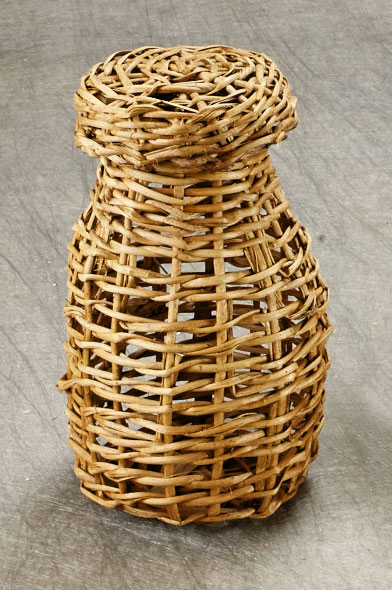
This basket is made from the aerial roots of the ‘ie‘ie plant that must be carefully gathered from the forest. It is no longer as abundant as it was. It is difficult to gather, and care must be given to the plant during harvest, so as not to harm the mother plant. The aerial root is covered with a thin bark that is carefully scrapped off within a week of gathering. The cleaned root is dried to cure it for use. When ready for weaving, it is soaked to make it flexible, then split and graded for size.
Each basket is woven free-form, and every shape is unique. -
HĪNA‘I - Circular Fish Trap
Open or CloseFish swim into the circular trap through the hole in the top to feed on the bait. They swim around and around inside but don’t exit through the hole on the top. To empty the trap, the rock and coconut cloth are removed from the bottom. The trap is dyed with kukui tree bark, which darkens its color for camouflage and also preserves the fiber.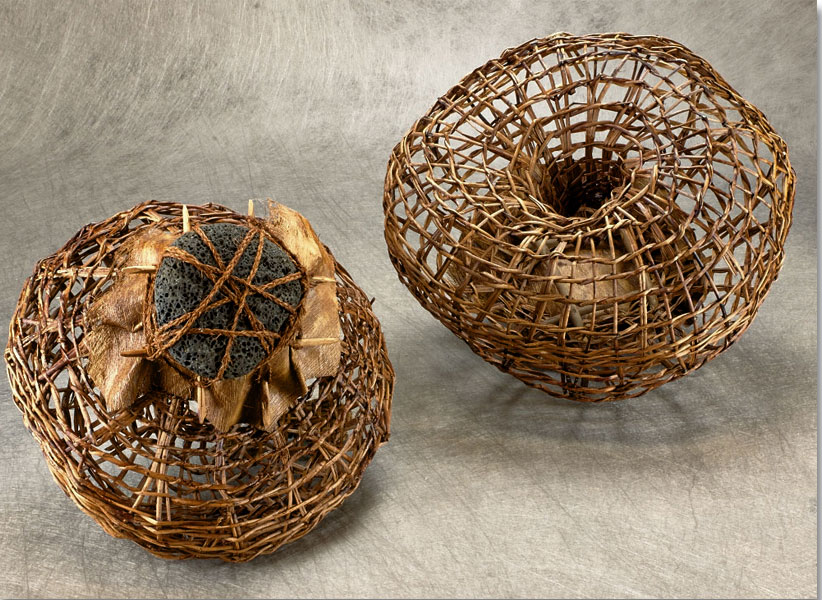
This trap is made from the aerial roots of the ‘‘ie‘ie plant that must be carefully gathered from the forest. It is no longer as abundant as it was. It is difficult to gather, and care must be given to the plant during harvest, so as not to harm the mother plant. The aerial root is covered with a thin bark, that is carefully scrapped off within a week of gathering. The cleaned root is dried to cure it for use. When ready for weaving, it is soaked to make it flexible, then split and graded for size.
Each trap is woven free-form, and every shape is unique.
-
HĪNA‘I POE POE - Basket Covered Gourds
Open or CloseA basket of ‘ie’ie is woven around a gourd to protect the gourd, and for decoration. The woven baskets of Hawai‘i surpass any twined work using similar material in the rest of Polynesia.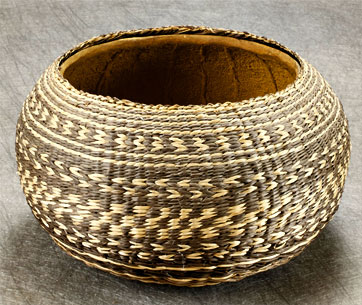
People of status kept their personal belongings in basket-covered gourds. This size basket gourd may have held feather lei, jewelry or other small items.
The aerial roots of the ‘ie’ie plant must be carefully gathered from the forest. It is no longer as abundant as it was. It is difficult to gather, and care must be given to the plant during harvest, so as not to harm the mother plant. The aerial root is covered with a thin bark that is carefully scrapped off within a week of gathering. The cleaned root is dried to cure it for use. When ready for weaving, it is soaked to make it flexible, then split and graded for size.
The design is created by dyeing some of the material with kukui bark and integrating it into the pattern. The light color is the natural color of the ‘ie’ie.
The design depicts the legend of Hawai‘i Loa, the Chief who led his canoes to discover Hawai‘i and gave the islands their name. He was guided by the ‘Iwa (Frigate) Bird and the manō (shark). On the bottom gourd the large dark band represents the ocean. Above are the arrow shapes representing shark teeth. Next is a band of shapes representing the ‘Iwa Bird in flight. The band of arrow shapes represents the shark. The bands of arrows going in opposite directions represent infinity. The cover of the basket has a decorative stripe representing the sea below and the next band has the arrows representing the teeth of the shark.
Loops of 2-ply olonā cord are woven into the basket and used to hold the top onto the bottom of the gourd. This net is tied in a traditional manner.
Olonā fiber is the strongest fiber in the world and is native only to Hawai‘i. Now it is very rare. It is also used for fishing line, nets, and on the capes and helmets of the chiefs. It must be gathered by stripping the bark off of the plant, soaked to remove vegetative matter, cleaned and cured before it can be made into cordage. -
MAKAU - Fish Hooks
Open or CloseFish hooks were made in a variety of shapes and sizes and used for a wide range of fish from tiny reef fish to large tuna and sword fish. There are two categories of fish hooks: Angular, or jabbing for setting into the jaw of the fish, and circular hooks for setting in the gills.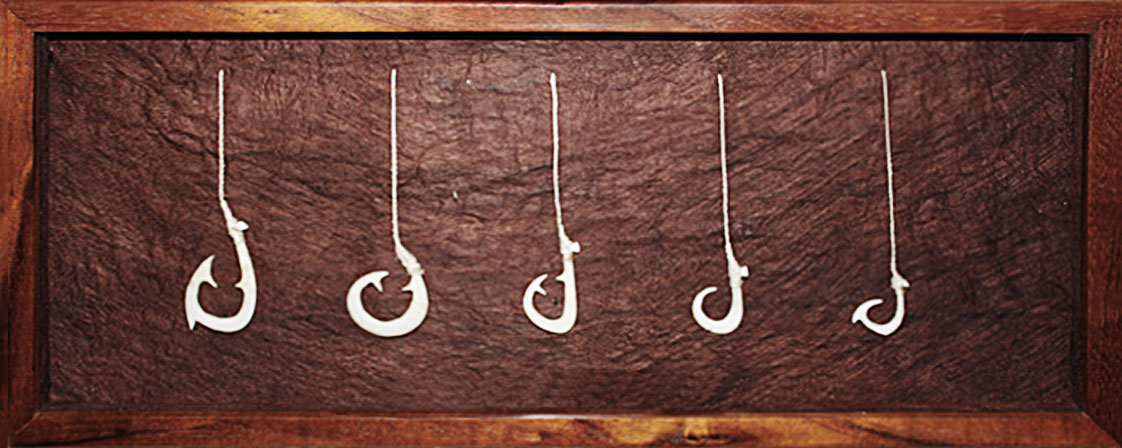
The fish hooks are tied with olonā fiber. Olonā was used for its strength and durability and is one of the strongest fibers in the world. It is found only in Hawai‘i. The hooks are mounted in Koa wood frames, a wood found only in Hawai‘i and mounted on kapa cloth dyed with hukui tree bark
By rediscovering the traditional practices and skills of our ancestors,
we protect the land and ocean resources for our future.
- http://www.garyeoff.com/resources/WoodBG.jpg

Educational material by Gary Eoff are licensed under a Creative Commons Attribution-NonCommercial-NoDerivs 3.0 Unported License.
Site Design: Colorwave Imaging